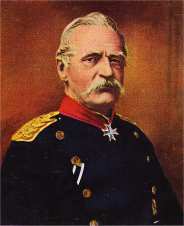Albrecht Graf von Roon
| Albrecht Graf von Roon | |
|---|---|

Albrecht von Roon
|
|
| Nickname(s) | The Great Silent One (Der große Schweiger) |
| Born |
30 April 1803 Pleushagen, Prussia (now Pleśna, Poland) |
| Died | 23 February 1879 (aged 75) Berlin, Germany |
| Allegiance |
|
| Service/branch | Prussian Army |
| Years of service | 1821–1870s |
| Rank | Generalfeldmarschall |
| Battles/wars |
Second Schleswig War Austro-Prussian War Franco-Prussian War |
| Awards |
Pour le Mérite Order of the Black Eagle Order of the Red Eagle House Order of Hohenzollern Order of the Crown (Prussia) Johanniter Order Iron Cross |
Albrecht Theodor Emil Graf von Roon (30 April 1803 – 23 February 1879) was a Prussian soldier and statesman. As Minister of War from 1859 to 1873, Roon, along with Otto von Bismarck and Helmuth von Moltke, was a dominating figure in Prussia's government during the key decade of the 1860s, when a series of successful wars against Denmark, Austria and France led to German unification under Prussia's leadership. A conservative and reactionary supporter of the monarchy, he was an avid modernizer who worked to improve the efficiency of the army.
Roon was born at Pleushagen (now Pleśna), near Kolberg (now Kołobrzeg, Poland). His family was of Flemish origin and had settled in Pomerania. His father, an officer of the Prussian army, died in poverty during the French occupation of the Kingdom of Prussia (see Napoleonic Wars), and the young Roon was brought up by his maternal grandmother.
Roon entered the corps of cadets at Kulm (now Chełmno, Poland) in 1816, from where he proceeded to the military school at Berlin in 1818, and in January 1821, he received a commission in the 14th (3rd Pomeranian) regiment quartered at Stargard in Pomerania. In 1824, he went through the three-year higher course of study at the General War School in Berlin (later called the Prussian Military Academy), where he improved his general education. Two years later, he was transferred to the 15th regiment at Minden.
In 1826, he was appointed an instructor in the military cadet school at Berlin, where he devoted himself especially to the subject of military geography. He was a student of the noted geographer Carl Ritter who taught at the Berlin military school. In 1832, Roon published the well-known Principles of Physical, National and Political Geography, in three volumes (Grundlage der Erd-, Völker- und Staaten-Kunde), which gained him a great reputation, and of which over 40,000 copies were sold in a few years. This work was followed in 1834 by Elements of Geography (Anfangsgrunde der Erdkunde), in 1837 by Military Geography of Europe (Militärische Landerbeschreibung von Europa), and in 1839 by The Iberian Peninsula (Die Iberische Halbinsel).
...
Wikipedia
